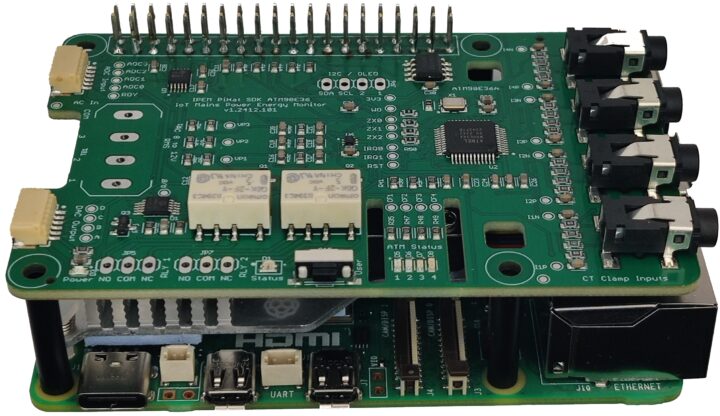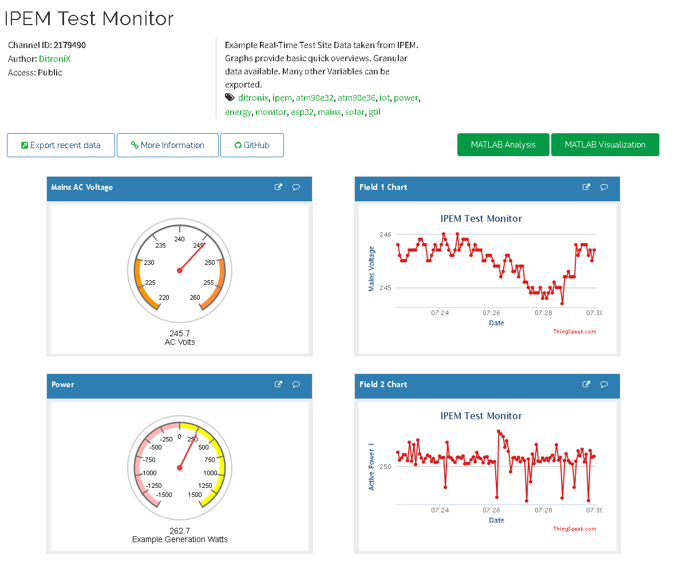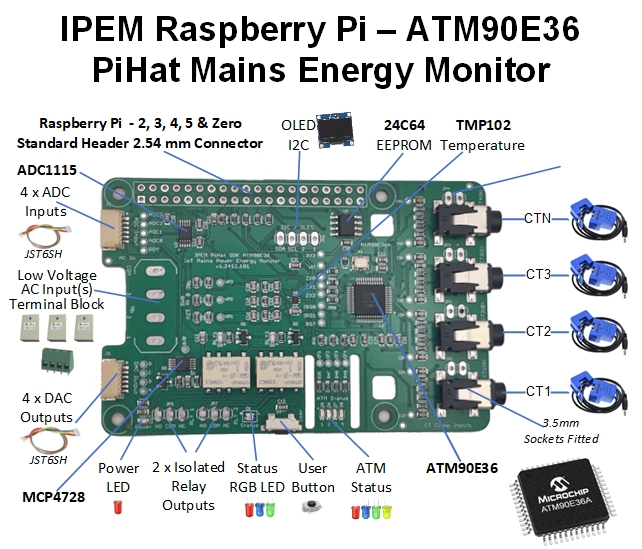The IPEM PiHat is a HAT (Hardware Attached on Top) board for the Raspberry Pi that turns the single-board computer into a mains power energy monitor with four CT clamps. It provides an accurate way to track energy usage in home, office, and solar energy systems and is compatible with single-phase, two-phase, and three-phase electrical systems.

The Raspberry Pi-based power energy monitor uses CT (current transformer) cable clamps to sample and measure data which can be used to report and analyze electric energy usage. This data can be used to save and divert energy to reduce costs and inefficiencies.
The system is easy to set up and does not require a professional electrician. It uses a CT current clamp clipped over the building’s main power cables and connected to the local mains circuit for voltage and frequency measurement. The add-on board comes in two variants: IPEM PiHat and IPEM PiHat Lite. The PiHat has the Microchip ATM90E36 at its core, while the PiHat Lite features the ATM90E32.
Both devices can be useful for applications and premises such as smart meters, EV charging, homes, schools, offices, factories, farms, and off-grid systems. We have covered similar CT clamp-based power monitors like the Emporia Vue Gen 2, SONOFF POW Ring smart power meter, and J.G.Aguado’s Smart Powermeter.
IPEM PiHat specifications:
- Monitor IC – Microchip ATM90E series (PDF) – See differences in the Current Measurement section
- Microchip ATM90E36 Energy Monitor
- Microchip ATM90E32 Energy Monitor
- Memory – 24C64 I2C EEPROM for parameters, data logging, and configuration
- Digital-to-Analog Converter
- Microchip MCP4278 12-bit I2C DAC
- 4x independent buffered output channels
- Onboard DAC EEPROM
- Configurable solder pads
- Analog-to-Digital Converter
- Analog Device ADS1115 16-bit I2C DAC
- 4x analog (3.3V max) inputs
- Isolated Relay Control
- 2x independent 30V 2A normally open or closed outputs
- External control based on time or current
- Current Measurement
- ATM90E36
- 3-phase line CT clamp input (CT1, CT2, CT3)
- Neutral CT Clamp (CTN)
- 3 x Voltage Inputs (AC RMS)
- Power Modes Settings
- ATME90E32
- 3-phase line CT clamp input (CT1, CT2, CT3)
- 3 x Voltage Inputs (AC RMS)
- Power Modes Settings
- ATM90E36
- 4x 3.5mm sockets for CT clamps (CT1, CT2, CT3, CTN)
- Interfaces
- GPIO, I2C, UART, I2C OLED
- Standard 40-pin Raspberry Pi GPIO header (unsoldered)
- Misc
- 4x ATM status LEDs, 1x WS2812 status RGB LED
- TMP102 I2C ambient temperature sensor, 1x user button
- Power Supply – 12V AC input terminal block (unsoldered)

The PiHat power energy monitor doesn’t connect to the cloud. Data can be published via MQTT, ThingSpeak, Domoticz, Zabbix, or Home Assistant. The FliX firmware for DitroniX Power Energy Monitor SDK Boards is completely open-source and available on GitHub.
The IPEM PiHat power energy monitor campaign is live on Kickstarter, with a funding goal of just $910 and several days to go. The IPEM PiHat board costs about $44, while the IPEM PiHat Lite version costs about $30. A STEM keyring ruler is included with every purchase. Deliveries are expected right after the crowdfunding campaign ends in February 2025.

Tomisin is a writer specializing in hardware product reviews, comparisons, and explainers. He is very passionate about small form factor and single-board computers.
Support CNX Software! Donate via cryptocurrencies, become a Patron on Patreon, or purchase goods on Amazon or Aliexpress





